| C. & L. Hill Limited Iron foundries and brass foundries were
once a common sight in the Black Country, where cupola
furnaces could be seen in every town. Some foundries
produced finished products that were sold under their own
name, but the majority supplied the essential castings that
formed some of the major parts of locally made items.
One such foundry was C. & L. Hill
Limited, which started life in Doctor’s Piece, Willenhall.
The business was founded by Charles and Lemuel Hill, on 13th
December, 1899, to manufacture small brass castings for the
trade. Early products ranged from stair rod eyes to six inch
diameter door knobs. Around thirty moulders were employed in
the foundry, and business was good. The company soon outgrew
the small factory and looked around for a new site on which
to expand.
In 1913 a new factory was built in
Stringes Lane, which consisted of a brass foundry, and an iron
foundry. During the First World War considerable numbers of
cast iron annealing pans, cast brass shell adaptors, brass
shell hoses, and petrol can caps were produced.
In 1920, the two company founders died within a
few weeks of each other. On 29th June, 1921 a limited
company was formed under the chairmanship of Mr. Maurice
Slater. The board of directors (of which there were four) included Mr. A. E. Owen,
Managing Director of Rubery Owen in Darlaston. The new
company operated from the premises in Stringes Lane, and
owned houses in Victoria Street and John Harper Street. |
|
In the early 1920s there were large
numbers of brass foundries in the area, and so competition
in the production of small brass castings for the trade was
rife.
The directors decided that the best way forward was
diversification, and so the foundry was extended to produce
non ferrous castings for the engineering and electrical
trades, and annealing pans. An aluminium foundry was added
in 1922.
On 30th December, 1929 Mr. A. E. Owen
died. He was replaced on the board by his son Mr. A. G. B.
Owen, who was appointed Managing Director in March 1930. |

| Mr. Maurice Slater.
From 'Goodwill' staff magazine, spring 1948. |
|
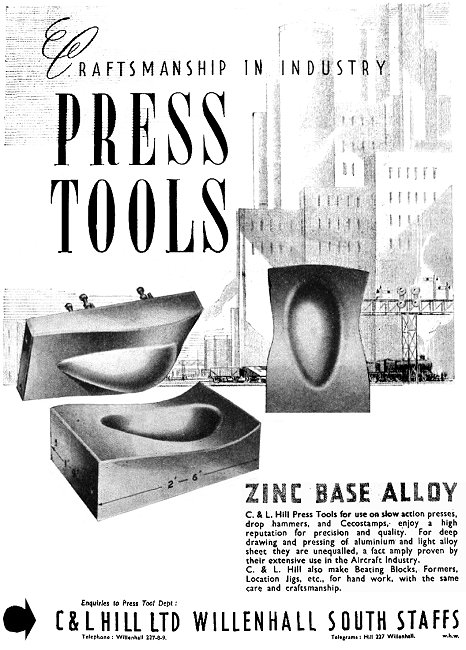
An advert from 1943.
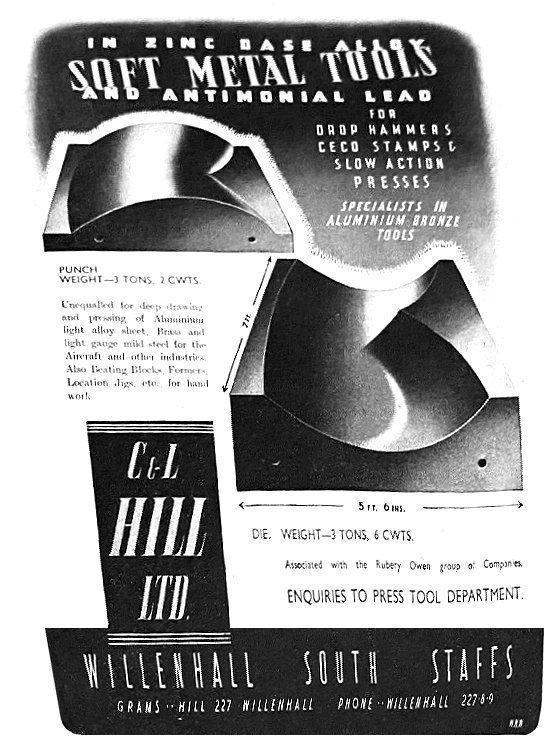

Hand casting in the foundry. From
'Goodwill' staff magazine, spring 1947. |
In 1930 the foundry was extended again, this time to
produce chill cast phosphor bronze bars for the engineering
trade. In 1934 the annealing pan business was sold, and in
early 1935 the decision was taken to reduce the company's
capital. This resulted in the business being put into
voluntary liquidation, and reconstructed by the formation of
a new company with the same name (C. & L. Hill Limited) to
take over the business and part of the assets.
The new company was incorporated on 10th April 1934. |
| With the sale of the iron foundry, the firm specialised
in non-ferrous sand castings and non-ferrous alloys. Chill
cast phosphor bronze bars known as "Hilchil Phosphor Bronze
Bars" were also produced.
Admiralty contracts were secured for the
production of bronze castings for electric switch boxes, and
cores, which in 1937, as part of the rearmament programme,
led to large Admiralty orders. Products for the Admiralty
included torpedo parts, switch
boxes, and electrical equipment for navy vessels. This led
to the enlargement of the foundry, and the installation of
new plant. |
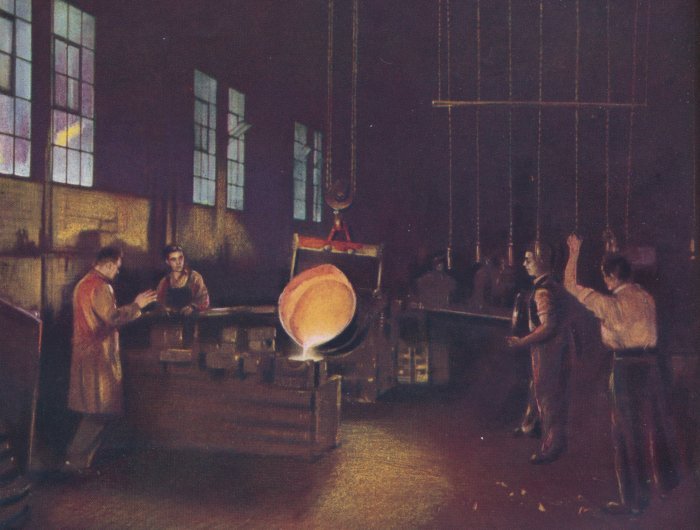
Casting a large mould. From 'Goodwill'
staff magazine, spring 1948. |
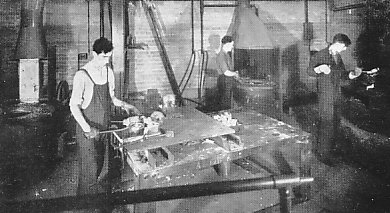
A corner of the aluminium gravity die
casting department. From 'Goodwill' staff magazine, spring
1948. |
During December 1939 a branch works
opened in Wednesfield Road, Willenhall.
At the outbreak
of war, both foundries began producing war work for the
Admiralty, the Ministry of Supply, and the Ministry of
Aircraft Production.
The two foundries worked flat-out to
complete the orders and new plant was installed at
Wednesfield Road. One important product was bronze compass
coil corrector cases to combat German magnetic mines.
|

Hill's jubilee dinner at the
Rubery Owen Concert Hall, on October 13th, 1949. From
'Goodwill' staff magazine, Christmas 1949. |
|
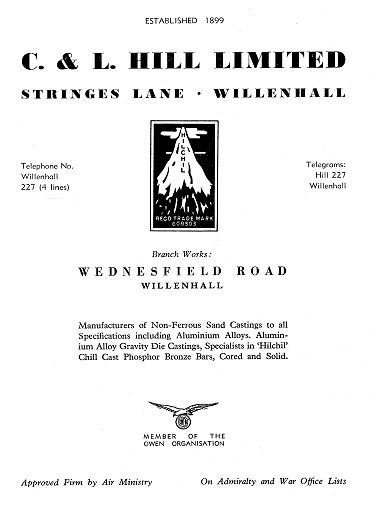
An advert from 1954. |
During the Battle of Britain, the
company began to manufacture press tools for the aircraft
industry, and developed a range of zinc base tools for the
production of air intakes, and fuel tanks etc. Hill’s
produced the oil fuel tanks for De-Havilland Mosquitos,
petrol tanks for Supermarine Spitfires, and tools for the
Short Brothers’ Sunderland flying boats. In 1944 the company became part of the
extensive Owen Organisation, after Rubery Owen & Company
Limited began to invest in the business. Hill’s war work for the aircraft industry led to the
development of zinc alloy tools for the production of items
made from Perspex, and also tools for the production of
rubber handle bar grips. In order to ensure that demand
could be met, a number of centrifugal machines were
installed at the factory.
The two foundries were organised into
six departments, which included a laboratory and research
department. Castings were made in brass,
gunmetal, phosphor bronze, copper, aluminium alloy, light
alloy, zinc, and lead. Chill cast bars, and gravity die
castings were also produced. One of the departments
specialised in metal refining.
|
|
Castings were produced to 44
specifications, in weights of 1 oz. to 1 ton. Zinc tool
castings were made up to 4 tons. Customers included the
motor, and aircraft manufacturers, atomic energy companies,
and the general engineering trade.
|
|
New offices were opened at Stringes
Lane in June 1949, followed by a new canteen in September
1951.
Staff members fully participated in the various social
activities that took place within the Owen Organisation.
Hills had an active horticultural society, a rifle club, and
an angling club, which regularly competed with similar clubs
run by the other factories in the organisation.
Staff members also competed at sports events, often held locally at Rubery Owen’s sports ground at Bentley. There were also day
outings, and social events in the canteen, organised by the
canteen committee.
In the canteen, workers could play darts, and snooker
etc.
|
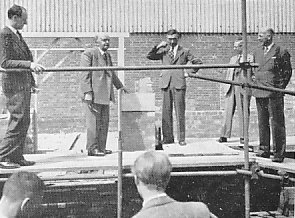
The stone laying ceremony at the new
offices. Left to right: Mr. A. G. B. Owen, Mr. Maurice
Slater, Mr. W. Bradley (builder), Mr. A. Griffiths (Rubery
Owen), and Colonel Lindop (director). From 'Goodwill' staff
magazine, autumn 1949. |
|
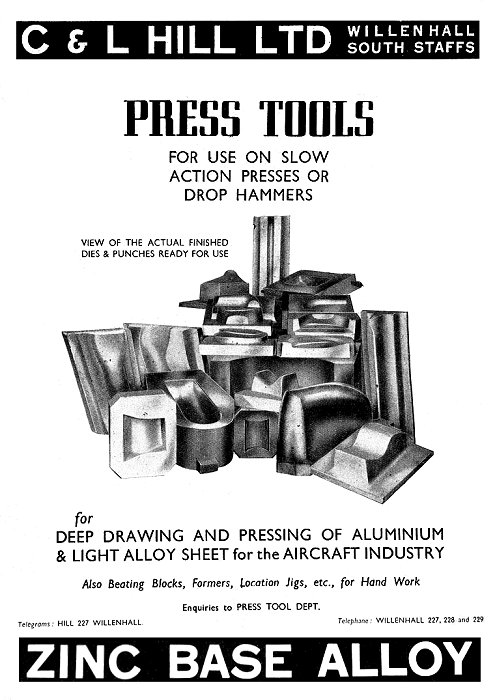
An advert from 1943. |
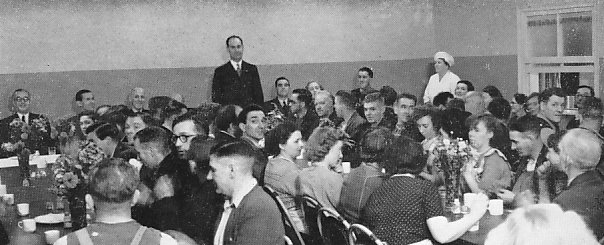
Mr. A. G. B. Owen making a speech
at the opening of the new canteen. From 'Goodwill' staff
magazine, Christmas, 1951. |
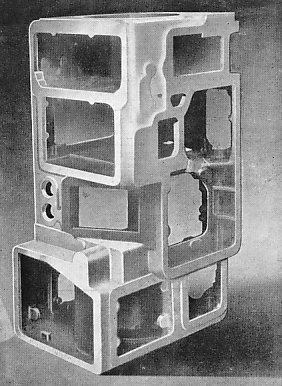 |
|
Examples of some of the
intricate, high quality castings that were produced in
the foundry. On the left is a gun metal sand casting,
and above are aluminium gravity die castings.
From 'Goodwill' staff magazine,
spring 1948. |
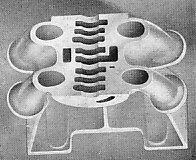 |
Two gun metal sand castings,
sectioned to show the cored ports.
From 'Goodwill' staff magazine,
spring 1948. |
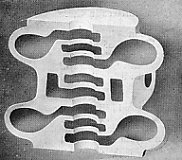 |
|
In 1971 Rubery Owen & Company Limited
bought the last remaining 33.3% preference shares. Sadly the
factory closed in 1972 and the property was sold. C. & L.
Hill Limited had the following subsidiaries: Central
Patternmaking Company Limited; Hill, Alzen Sales Limited;
and C. & L. Hill (Die Castings) Limited. In 1981 the dormant
company changed its name to Rubery Owen (Pressings &
Fabrications) Limited.
Based on articles and reports from
editions of ‘Goodwill’, the Owen Organisation’s magazine;
and the Owen Group records.
|
 |
Return to
the
previous page |
|